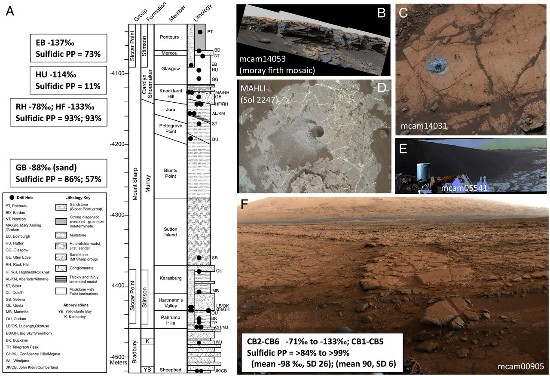The launch of NASA’s James Webb telescope has astronomers and exobiologists excited about what we will learn about exoplanet environments as this decade unfolds. This space-based observatory will provide us with unprecedented data on the composition of exoplanet atmospheres, something that has been much harder to do with the Hubble and earthbound telescopes. If we detect exoplanets in Goldilocks Zones with atmospheres containing a mix of nitrogen, oxygen, water vapour, and some carbon dioxide (CO2) it won’t be a leap of faith to declare we have found a second Earth and alien life. Oxygen’s presence alone doesn’t indicate life, but the blend of these four and temperatures in which liquid water can exist on a planet’s surface match the conditions for life here.
But in our own Solar System neighbourhood, we may have already uncovered the evidence for life on our neighbour, Mars. Mars has oxygen tied up in its regolith. It is oxygen bonded to iron that creates its rusty colour. It also has water in the form of ice which can be seen at its poles and has been detected very close to the planet’s surface. Its atmosphere is largely CO2. And its daytime temperatures often reach well above the freezing temperature of water. Although at night it gets colder than any location on Earth.
NASA has always been circumspect about what its two Viking landers discovered back in 1976 in sampling experiments that identified organics in the surface regolith. Some of NASA’s scientists interpreted the results of these experiments as showing evidence of past life, while others ascribed the data received as nothing more than unique Martian inanimate chemical interactions.
Since Viking, several NASA and one Chinese rover have landed on Mars. The NASA rovers active currently have been equipped with onboard laboratories that don’t specifically look for life, but rather look for conditions in the past that could have supported it.
In the last week, NASA’s Curiosity rover made science headlines when a paper appearing in the Proceedings of the National Academy of Sciences (PNAS) described experiments on 24 powder samples at Gale Crater using SAM (the Sample Analysis at Mars instrument) released methane (CH4). A NASA press release issued on January 17th stated that the rover had found myriad organic molecules that here on Earth are considered signatures for life.
In the PNAS paper it describes the three possible explanations for the presence of CH4 in the samples:
- photolysis of biological methane released from the subsurface
- photoreduction of atmospheric carbon dioxide (CO2)
- deposition of cosmic dust during passage through a galactic molecular cloud.
All three scenarios would be unlike anything here on Earth. A further explanation is warranted for all three.
Photolysis is the chemical breakdown of compounds when exposed to light.
Photoreduction breaks apart CO2 molecules and in this case, combines carbon and hydrogen atoms to form molecules of CH4.
And cosmic dust deposition is easier to detect on Mars with its thin atmosphere than here on Earth. Cosmic dust is ubiquitous throughout the Universe. It’s what composes nebulas the one in the constellation Orion. It’s the stuff that gives birth to stars and planets.
 In the above image, we can see from where Curiosity’s samples were derived in Gale Crater. The rover drilled into the surface of what scientists describe to be a dried-out lake bed where free-flowing water once existed billions of years ago.
In the above image, we can see from where Curiosity’s samples were derived in Gale Crater. The rover drilled into the surface of what scientists describe to be a dried-out lake bed where free-flowing water once existed billions of years ago.
The harvested samples if found on Earth would have been explained as the paleontological remains of microbial life when the atmosphere of our planet contained CH4 in abundance. Today, however, equivalent environments here exist mostly underwater in marine seeps found on the seafloor along continental margins. Seeps leak CH4 which freeze in deep water, or bubble to the surface and into the atmosphere when located in shallows. Some scientists believe it was contact with frozen hydrates that caused the explosion on the Deepwater Horizon rig and subsequent oil spill disaster in 2010.
The PNAS paper notes in its review of the sampling that non-biological explanations for CH4’s presence can be explained by the CO2-rich atmosphere of Mars, or by interstellar cosmic dust raining down on the planet’s surface. A fourth explanation is also briefly discussed that suggests an electrochemical rather than photoreduction reaction with atmospheric CO2 being converted to organic molecules abiotically.
So we still don’t have the answer to the question, does Mars or did Mars have life? And the technology currently roving the surface won’t tell us one way or another. That’s because both rovers don’t have definitive testing ability to rerun the Viking lander tests that first hinted at past or present microbial life on Mars. It would seem that NASA deliberately has not wanted subsequent missions to Mars to find that answer which seems awfully strange.
Perseverance with its sampling at the Jezero Crater on Mars and the materials it is caching for a future sampling return mission in the 2030s in running the same tests as Curiosity is likely to produce similar results. We will find organics but not know what produced them.
The next opportunity to solve the origin of organics on Mars must wait to the next rover, The Rosalind Franklin ExoMars mission. This European Space Agency and Russian cooperative mission is expected to launch this year and arrive on Mars in 2023. This rover can drill two metres (6.6 feet) into the Martian subsurface to obtain samples. It intends to go beyond the Viking lander experiments in studying not only organics but also the distribution of oxidants. Oxidants exist on Mars in the form of rust, perchlorates, and peroxides. Perchlorates and peroxides are inhospitable to life, but not rust which plays an important role in biological processes.








